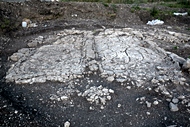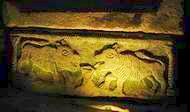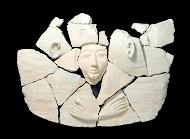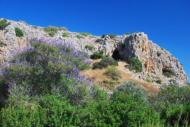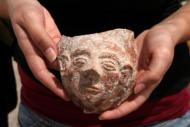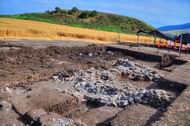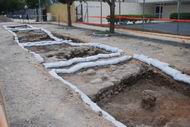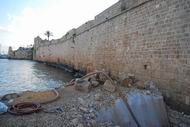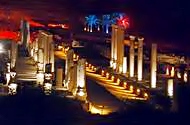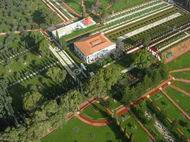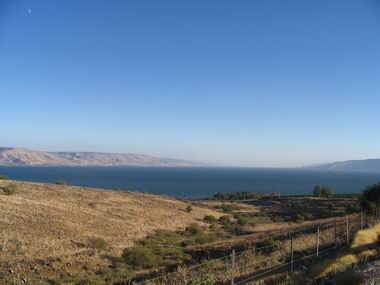This page presents news from the region of the Galilee, relating to its ancient sites.
Home > News > Galilee News
This page provides news about the ancient sites in the Galilee: News about archaeological digs, new findings, new sites, and other interesting news items.
The news items in this page include all the sub-regions (lower Galilee, Upper Galilee, etc.) of Northern Israel.
The items appear in reverse chronological order – last-in-first.
July 27, 2019: 3500 years old staircase revealed
A section of a 3500 years old monumental staircase leading up to the Canaanite palace was revealed in Hazor. The staircase is 4.5m wide, and made of large basalt slabs. Seven steps were unearthed so far in this section.
> More on Tel Hazor see here.
Mar 5, 2017: Carved Dolmens
A rare Dolmen was found in the Golan, near Kibbutz Shamir. The unique feature was the discovery of carvings on its ceiling.
Read more on Dolmens in the Golan and the newly found Dolmen in the links section of that page.
Apr 12, 2016: Jalame Glass factory
Remains of a Late Roman period glass factory was found in 2016 at the side of the new railroad, in Jalame – 200m west of Tel Me’amar. According to the IAA report this was “the oldest glassworks ever found in Israel”, and “a world center for glass making in Antiquity”.
Read more here.
Dec 18, 2015: Kursi
Excavations at the Kursi harbour site have uncovered an inscription in Hebrew letters engraved on a large (140 cm by 70 cm) marble slab, dating to the 5th Century AD. This finding may suggests that the city, in the Land of the Gederenes”, was Jewish at the time of Jesus.
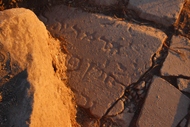
July 6, 2015: Beit Shearim – World Heritage
The catacombs of Beit Shearim were declared a UNESCO World Heritage site in July 2015.
July 1, 2014: Join a dig
Call for volunteers – a dig in Beit Shearim (Sep 7 – Oct 2, 2014)
Contact aerlich@research.haifa.ac.il
April 2014: Discovery at Tell Shadud
The IAA announced the discovery of rare artifacts during a salvage excavation at the foot of Tel Sarid (Tell Shadud). A 3,300 year old cylindrical coffin was one of the exciting findings. It was probably the burial place of a wealthy Canaanite, possibly an official of the Egyptian army.
June 29, 2012: Carmel Caves – World Heritage sites
The Carmel caves were listed as UNESCO World Heritage sites. These include the Tabun (Tanur), el Jamal (Gamal), el-Wad (Nahal) and Skhul (Hagedi) caves.
Read more about it:
- The early man caves in the Carmel caves’ page.
- UNESCO page.
Aug 15, 2011: Hercules in Jezreel valley
A small marble statue of Hercules was found in the salvage excavations of Khirbet Tarbenet in the Jezreel valley, as part of the Jezreel Valley railway re-construction project.
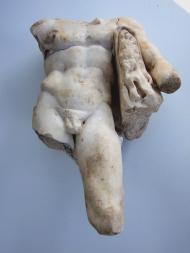
July 6, 2011: Ancient Sabbath marker found in Timrat
BibleWalks exclusive: ancient Sabbath marker was found on a rock near the communal settlement of Timrat.
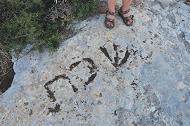
June 9, 2010: Tell Kassis discovery
Rare discovery of a hoard of cultic vessels dated to the Late Bronze period. Read about it here.
Photo courtesy of IAA
June 1, 2010: Gamala Nature reserve burnt
Gamala, one of the famous archaeological sites, was damaged by a fire that burnt in the nature reserve.
May 11, 2010: Tell Kassis excavations
The natural gas pipeline near Tell Kassis sparked riots of Druze landowners. Along its path the Archaeologists exposed large areas of the ruins of ancient residential and industrial areas. The civil and archaeology works continue under the watch of the police.
May 21, 2009: Acre excavations – Jehoshaphat street
“For the first time we are excavating remains of the city from the Byzantine period…”
Search for the lost cities of Acre (Akko)… Read about it here.
May 11-15, 2009: Papal visit
Pope Benedict XVI visited the Holy Land and Nazareth sites sites in May 2009.
April 4, 2009: Hellenistic pier excavated in Acre
A pier from the Hellenistic period were excavated in Acre.
Oct 18, 2008: Beit Shean nights
An amazing multi-media multi-sensory night tour has been recently being launched in the national park of ancient Beit Shean. The 3M$ project is the first of its kind in the world in an archaeological site, and the 4th largest in the world.
July 8, 2008: Bahai Gardens named UNESCO World Heritage Site
The two Bahai Gardens in Haifa and Acre have been named today UNESCO World Heritage site.
For more info – click on one of the links above and view these amazing sites.
The old city of Acre is already a UNESCO heritage site, receiving its inscription in 2001. This recognition brings more funds and new restoration projects into the city.
Oct 27, 2007: Tell Zibda excavations
Emergency excavations are conducted in Tell Zibda, as part of the preparations of the new Kerioth-Bypass highway. The site is located on the side of the coastal path of the ancient trade road, Derech Hayam (via Maris).
June 13, 2007: Atlit – Hellenistic site razed
Emergency excavations were conducted on a small hill, about 1KM south-east to the Atlit Crusaders castle area. The excavations revealed the foundations of an Hellenistic period farm house. Additionally, the dig unearthed the oldest known Columbarium (pigeon breeding cave/house) in ancient Israel, a round installation seen in the photo on the right.
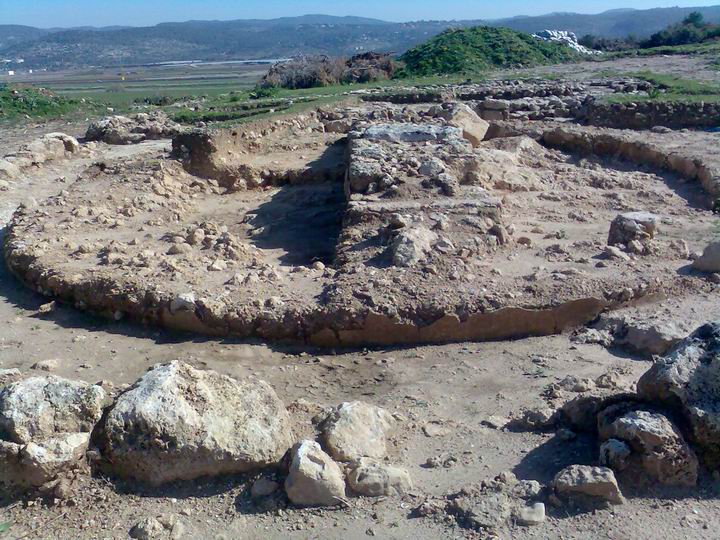
Feb 19, 2007: The Carmelites plan to build a Bahai-style garden
The Carmelites plan to build a 200M$ 6 Hectares garden on the Carmel, which will match the beauty of the Bahai faith Garden. In addition, they filed a plan for a major construction of 350 residence rooms and 100 hotel rooms in Stela Maris.
-
Reference: Ofer Petersburg – Ynet.
-
Details on the Carmelite order: See Keren-Carmel.
-
Details on Bahai garden: See Haifa overview.
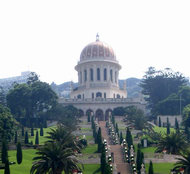
Feb 14, 2007: Sea of Galilee Circumference Trail faces objections
The Israeli Nature preservation society is designing a trail around the Sea of Galilee, and already prepared 35 out of the 60KM for a makeshift walking trail, which was cleared through the bush by volunteers. The plan is to transform the trail into a larger tourist project, such as the existing new section between Capernaum and Tabcha. One of its goals is to remove the private enterprises that shut many sections of the beaches around the lake, opening it to the public. A government panel recently authorized this project.
Surprisingly, the Ministry of Tourism – who should have pushed this project in order to attract more tourists- now submitted objections to the plans. Their objections concerns to one of the first sections to be built between Capernaum and Bethsaida. This northern section conflicts with other tourism plans, in association with evangelist groups. Other objections were raised on the concerns of possible damages to the holy sites near the trail.
Hopefully, it will be possible to resolve these objections and start moving the project soon.
View of the north of Sea of Galilee
Reference: “Yedioth Akhronot” (A. Ben David, I. Eichner; Feb 13, 2007)
Feb 13, 2007: Who is buried in the Holy Bar-Yochai Tomb?
Ancient tombs across the Galilee and Israel are visited by many religious Jewish groups who come to pray. In the last 10 years there is a rise in the number of people that come to Holy tombs, a phenomenon that is hard to explain. Dozens of such sites were rebuilt and revisited after many years of neglect. Every weekend there are hundreds of believers that tour the Tomb sites around Israel, asking for hearing their prayers. See examples: Benjamin tomb, Kefar Hannania.
Tombs near Kefar Hannania.
A historian from the Haifa University, Dr M Yazbak, claims that one of the most famous Jewish tombs, Rabbi Simon Bar-Yochai in Meiron, was actually a place of worship for both Muslim and Jewish, as documented in the 14th C texts. This tomb is visited by tens of thousands.
According to his research many of these tombs have been shared in the past by the 3 religions, where each of them claiming some link to one of their Holy ancestors. In recent years, however, many tombs have shifted to be Jewish, according to the Historian.
Link: Ynet
Reference: “Yedioth Akhronot” (E. Glickman; Feb 13, 2007)
Archives:
From our previous news clips:
(a) Aug 7, 2006 : War with Lebanon:
Unfortunately, the land of Israel witnessed many wars and bloodshed, and the cycle of war started again. The heavy number of rockets and missiles fired at the North of Israel in the past 4 weeks are causing heavy damages and lost lives. In addition, the explosions are burning up much of the forests and fields across the Galilee, especially in the Upper Galilee near the Lebanon border. The fire fighters are helpless in many cases since there are restrictions on flights, and due to the heavy shelling they are risking their lives. About half a million trees were burnt in the Galilee.
Although some rockets hit Nazareth, no historic sites are known to be damaged yet. There were, however, two kids that were killed in the city of Nazareth.
The following pictures were captured by our friend near Afula last week, when Fajar-5 Missiles hit the hill of Givat Hamoreh and set a fire to the trees. Note that Afula is a city in the middle of the Yizrael (Jezreel), south of Mount Tabor and south-east of Nazareth, and about 100KM from the launching sites in Lebanon. At the North side of this hill is the village of Naim, where according to Luke (7:11-17) Christ raised to life the widow’s son.
In the first photo below – two smokes (white and black) are rising from each of the missile hits.
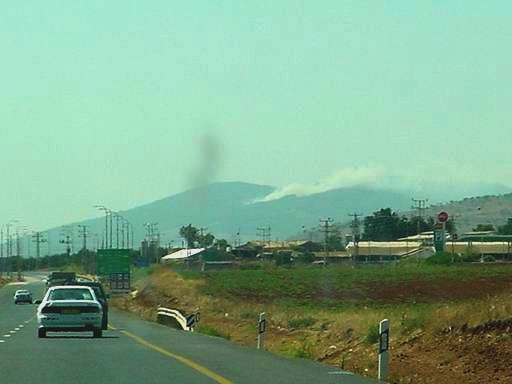
The next photo shows the fires that started after the attack.
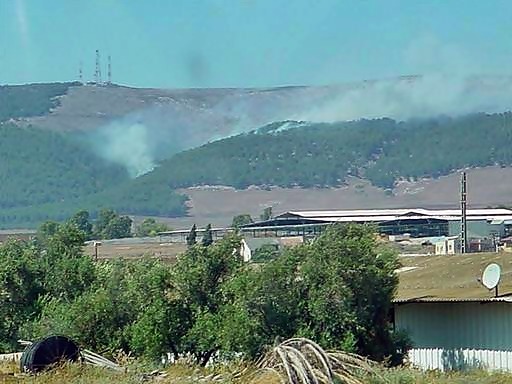
What is happening recently in the Galilee was already warned in the Bible by Jermiah (1:14): “The LORD said to me, “From the north disaster will be poured out on all who live in the land”.
BibleWalks.com – walk with us through the sites of the Holy Land
This page was last updated on July 27, 2019 (Added Hazor)
Sponsored links:
